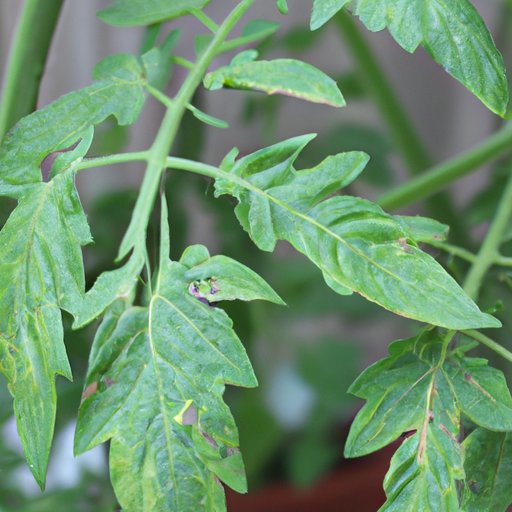
Introduction
Tomatoes are a staple in many kitchens throughout the world, used in various dishes ranging from salads to sauces. However, there is one question that has remained a topic of debate among food enthusiasts and health experts – Can you eat tomato leaves? This article aims to explore this topic and provide valuable insights into whether tomato leaves are safe and nutritious for consumption.
Eating Tomato Leaves: Is it Safe or Risky?
While tomatoes are incredibly safe to eat and offer a wide range of health benefits, the leaves, vines and stems that grow on the tomato plant pose certain risks. Tomato leaves, in particular, contain solanine, a toxic compound that can be harmful if consumed in large quantities or in a raw state. Solanine can cause symptoms like nausea, vomiting, digestive issues and even respiratory problems. Additionally, people with tomato allergies can have an adverse reaction to tomato leaves.
It is essential to note that no proven health benefits come from consuming tomato leaves. Studies show that they may possess some medicinal properties, but there is little evidence to support these claims. Therefore, the risks of consuming tomato leaves may indeed outweigh the benefits significantly.
Tomato Leaves: Nutritious Addition or Harmful Ingredient?
There is limited evidence to suggest that tomato leaves are a significant source of nutrition. They contain low levels of vitamins and minerals compared to other vegetables, and the toxic properties in them can cause negative health effects. While the occasional tomato leaf is unlikely to pose any threat, consuming large quantities could be dangerous.
It is not advisable to incorporate tomato leaves into your regular diet, considering the toxicity levels. Instead, focus on consuming other plant-based foods that offer a more significant nutritional impact on your overall health.
The Truth About Tomato Leaves: Dispelling Myths and Misconceptions
Over the years, there has been a considerable amount of misinformation surrounding the topic of tomato leaves and their safety for consumption. One common myth is that boiling tomato leaves makes them safe to eat, but this is untrue – the toxic properties in tomato leaves are not removed by boiling.
Another misconception is that tomato leaves are used to enhance the flavor of soups and broths. However, this is not the case, and any recipe that calls for tomato leaves should be excluded or substituted with an alternative.
The truth about tomato leaves is that they are not safe for consumption. As with any other plant or herb, it is essential to take caution and educate ourselves on the potential risks of consuming certain parts.
From Farm to Table: Are Tomato Leaves Safe to Eat?
Tomatoes are usually grown using pesticides and other chemicals that may be harmful to human health. These chemicals can accumulate on the leaves of the tomato plant, posing a potential risk to anyone consuming them.
Before consuming any tomato leaves, it is essential to wash them correctly with water and discard any wilted or damaged leaves. It is also crucial to purchase tomatoes grown using organic farm methods, which ensure that no pesticides or harmful chemicals are used in the growth process.
Tomato Leaves in Cooking: How to Use Them Safely and Deliciously
If you choose to consume tomato leaves, it is advisable to use them sparingly and only after careful preparation. Cooking them as opposed to eating them raw is considered the safest way to consume them, but there is always a risk involved.
One method to reduce the toxic content in tomato leaves is to dry them out in the sun or roast them. This helps in breaking down the harmful compounds, making them safer to consume. An excellent way to use these dried tomato leaves is to add them to salads or use them as a seasoning in various dishes.
Another cooking tip to safely use tomato leaves is to add them in a way that they are easily identifiable and can be removed. For instance, wrapping them around fish or vegetables in cooking before removing them before serving the dish.
Here are a few meal ideas to use tomato leaves safely and deliciously:
- Pesto sauce with basil and tomato leaves for pasta dishes.
- Tomato leaves are finely chopped and used as seasoning for meatballs and soups.
- Dried tomato leaves used as a seasoning for roasted vegetables.
Alternatives to Tomato Leaves in Cooking: What to Use Instead
If you prefer not to consume tomato leaves or are unwilling to take the risk, many other herbs and greens can be used in their place. These substitutes include:
- Basil – the most commonly used herb in tomato dishes with a similar flavor profile to tomato leaves.
- Kale – provides a nutritional richness like that present in tomato leaves, thus a healthy substitute.
- Spinach – also offers similar nutritional benefits and can be used in salads or in cooked dishes.
Conclusion
There is little evidence to suggest that consuming tomato leaves is safe or beneficial. It is essential to take caution and educate ourselves on the potential risks of consuming certain parts of the tomato plant. If you do choose to use tomato leaves in cooking, ensure that you use safe preparation methods and consume them in moderation. It is always advisable to consult with your doctor or a qualified nutritionist before incorporating any new food into your diet.





